DBS Bank: Reward Management, Employee Value Proposition and Strategy
VerifiedAdded on 2023/04/26
|11
|2639
|260
Report
AI Summary
This report analyzes reward management at DBS Bank, focusing on the employee value proposition (EVP), challenges, and impact on talent management. It examines DBS Bank's business nature and key success factors, proposing an EVP to attract and retain critical talent. The report evaluates the current reward strategy's effectiveness, identifies talent and business challenges, and assesses whether existing strategies adequately address them. A proposed reward strategy is formulated to address these challenges, emphasizing the importance of both monetary and non-monetary benefits. The report concludes by highlighting the impact of reward management on talent management, emphasizing its role in reducing absenteeism, boosting morale, and fostering team spirit. The human resource management's role in strategic reward planning is also discussed.
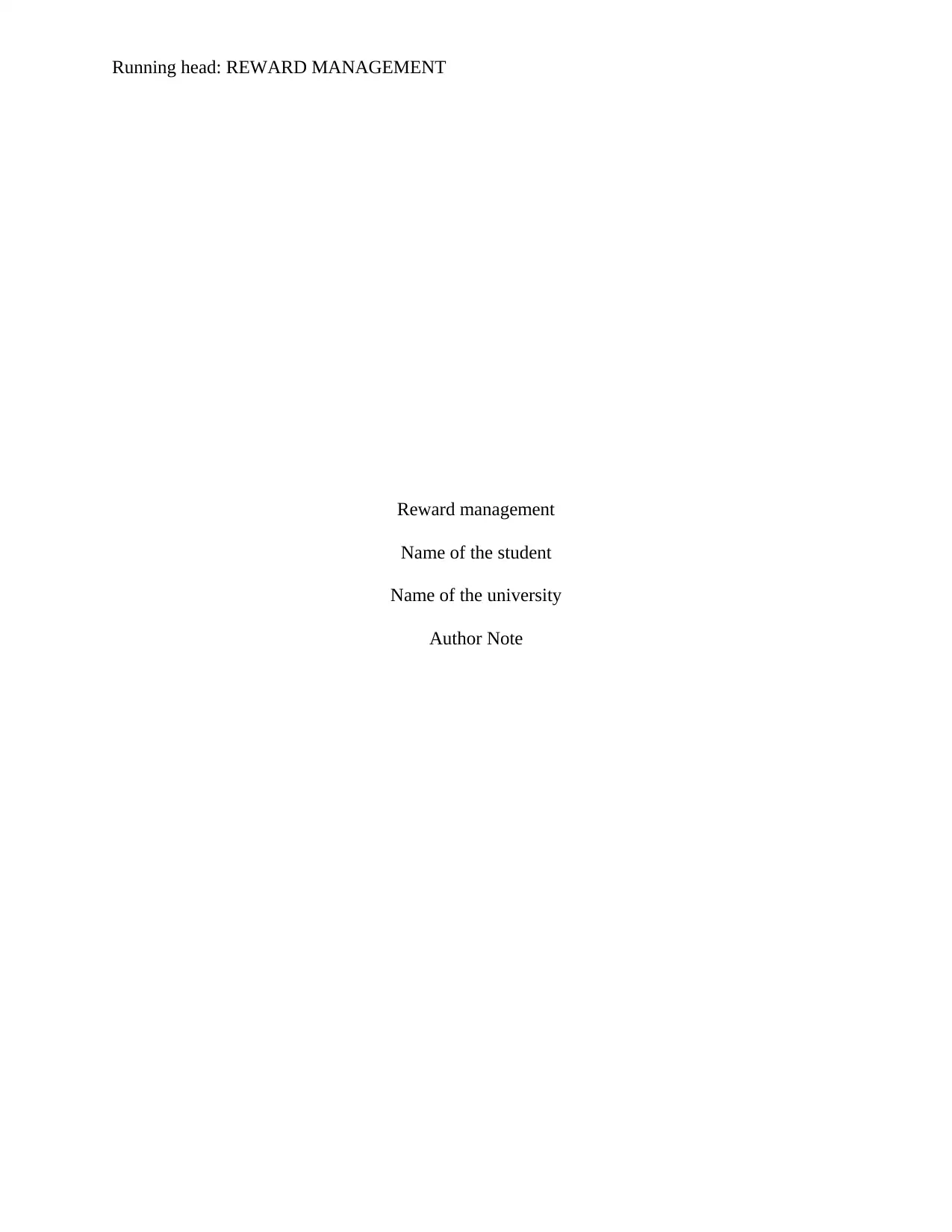
Running head: REWARD MANAGEMENT
Reward management
Name of the student
Name of the university
Author Note
Reward management
Name of the student
Name of the university
Author Note
Paraphrase This Document
Need a fresh take? Get an instant paraphrase of this document with our AI Paraphraser
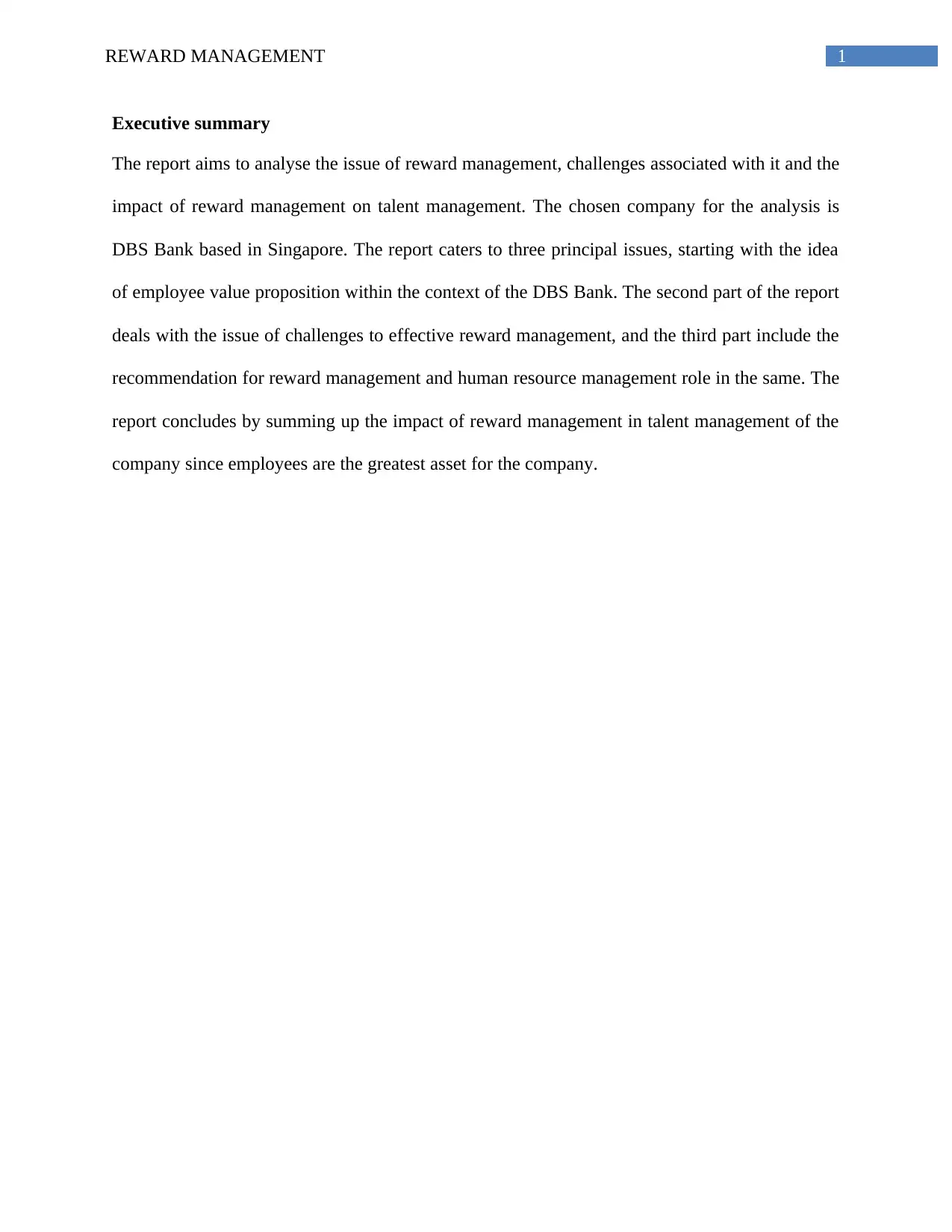
1REWARD MANAGEMENT
Executive summary
The report aims to analyse the issue of reward management, challenges associated with it and the
impact of reward management on talent management. The chosen company for the analysis is
DBS Bank based in Singapore. The report caters to three principal issues, starting with the idea
of employee value proposition within the context of the DBS Bank. The second part of the report
deals with the issue of challenges to effective reward management, and the third part include the
recommendation for reward management and human resource management role in the same. The
report concludes by summing up the impact of reward management in talent management of the
company since employees are the greatest asset for the company.
Executive summary
The report aims to analyse the issue of reward management, challenges associated with it and the
impact of reward management on talent management. The chosen company for the analysis is
DBS Bank based in Singapore. The report caters to three principal issues, starting with the idea
of employee value proposition within the context of the DBS Bank. The second part of the report
deals with the issue of challenges to effective reward management, and the third part include the
recommendation for reward management and human resource management role in the same. The
report concludes by summing up the impact of reward management in talent management of the
company since employees are the greatest asset for the company.
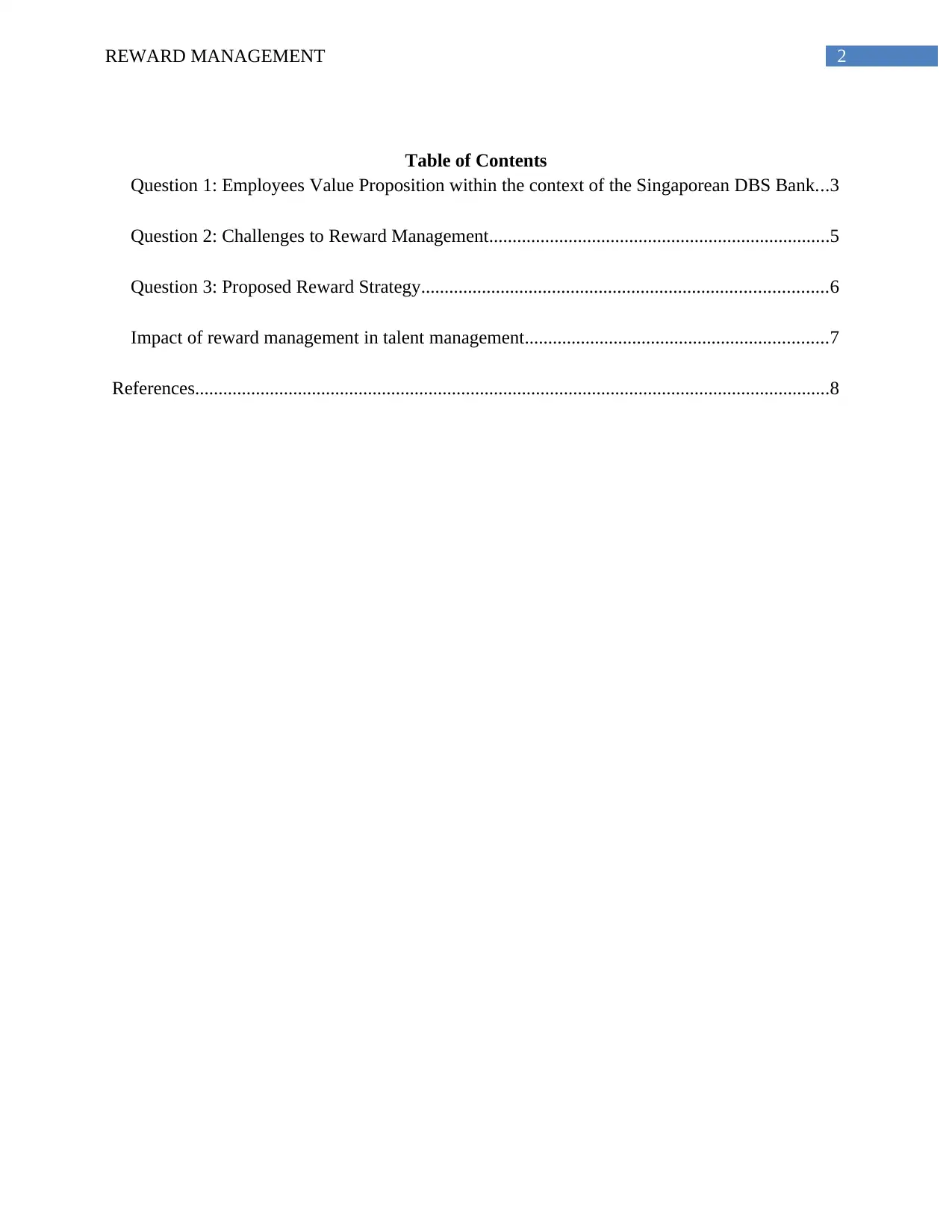
2REWARD MANAGEMENT
Table of Contents
Question 1: Employees Value Proposition within the context of the Singaporean DBS Bank...3
Question 2: Challenges to Reward Management.........................................................................5
Question 3: Proposed Reward Strategy.......................................................................................6
Impact of reward management in talent management.................................................................7
References........................................................................................................................................8
Table of Contents
Question 1: Employees Value Proposition within the context of the Singaporean DBS Bank...3
Question 2: Challenges to Reward Management.........................................................................5
Question 3: Proposed Reward Strategy.......................................................................................6
Impact of reward management in talent management.................................................................7
References........................................................................................................................................8
⊘ This is a preview!⊘
Do you want full access?
Subscribe today to unlock all pages.

Trusted by 1+ million students worldwide
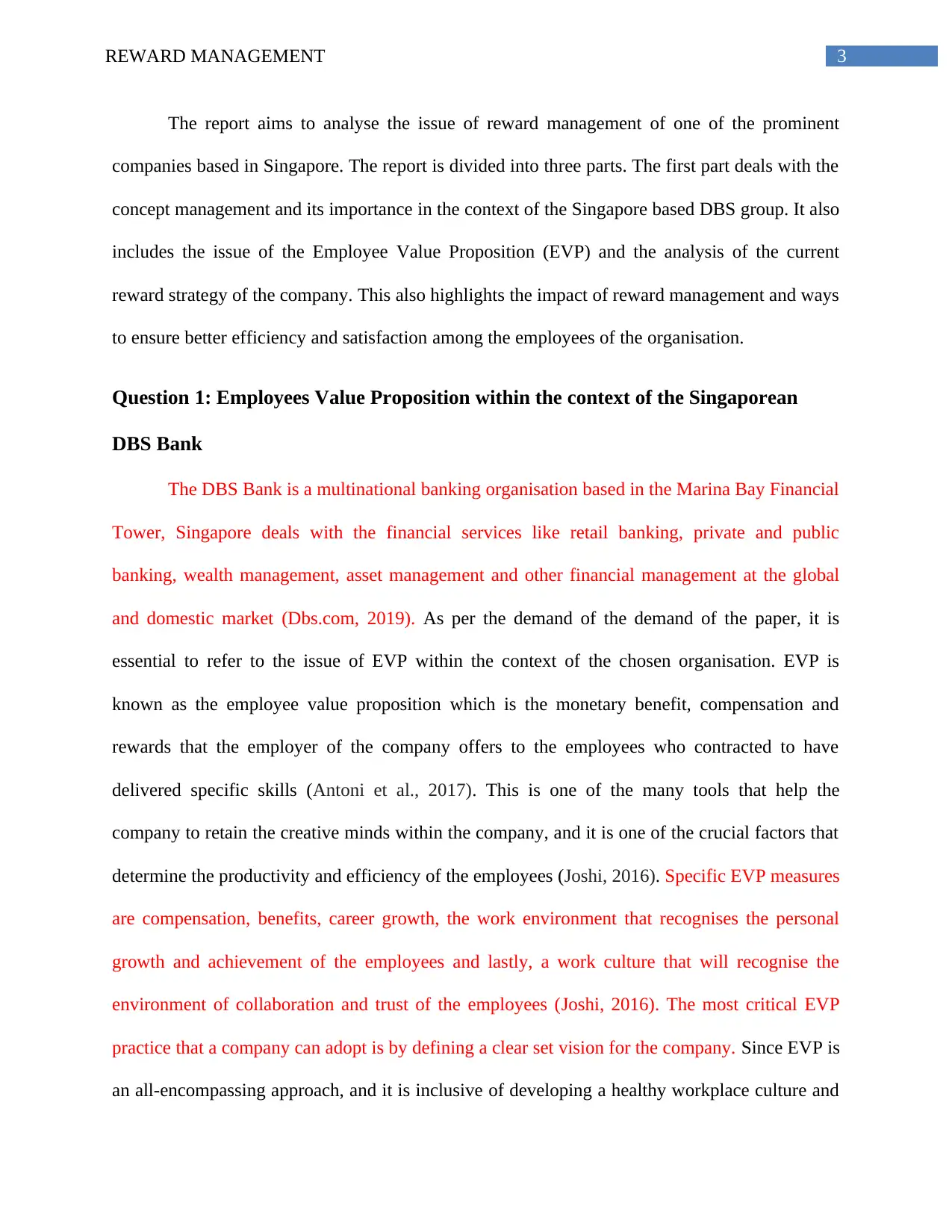
3REWARD MANAGEMENT
The report aims to analyse the issue of reward management of one of the prominent
companies based in Singapore. The report is divided into three parts. The first part deals with the
concept management and its importance in the context of the Singapore based DBS group. It also
includes the issue of the Employee Value Proposition (EVP) and the analysis of the current
reward strategy of the company. This also highlights the impact of reward management and ways
to ensure better efficiency and satisfaction among the employees of the organisation.
Question 1: Employees Value Proposition within the context of the Singaporean
DBS Bank
The DBS Bank is a multinational banking organisation based in the Marina Bay Financial
Tower, Singapore deals with the financial services like retail banking, private and public
banking, wealth management, asset management and other financial management at the global
and domestic market (Dbs.com, 2019). As per the demand of the demand of the paper, it is
essential to refer to the issue of EVP within the context of the chosen organisation. EVP is
known as the employee value proposition which is the monetary benefit, compensation and
rewards that the employer of the company offers to the employees who contracted to have
delivered specific skills (Antoni et al., 2017). This is one of the many tools that help the
company to retain the creative minds within the company, and it is one of the crucial factors that
determine the productivity and efficiency of the employees (Joshi, 2016). Specific EVP measures
are compensation, benefits, career growth, the work environment that recognises the personal
growth and achievement of the employees and lastly, a work culture that will recognise the
environment of collaboration and trust of the employees (Joshi, 2016). The most critical EVP
practice that a company can adopt is by defining a clear set vision for the company. Since EVP is
an all-encompassing approach, and it is inclusive of developing a healthy workplace culture and
The report aims to analyse the issue of reward management of one of the prominent
companies based in Singapore. The report is divided into three parts. The first part deals with the
concept management and its importance in the context of the Singapore based DBS group. It also
includes the issue of the Employee Value Proposition (EVP) and the analysis of the current
reward strategy of the company. This also highlights the impact of reward management and ways
to ensure better efficiency and satisfaction among the employees of the organisation.
Question 1: Employees Value Proposition within the context of the Singaporean
DBS Bank
The DBS Bank is a multinational banking organisation based in the Marina Bay Financial
Tower, Singapore deals with the financial services like retail banking, private and public
banking, wealth management, asset management and other financial management at the global
and domestic market (Dbs.com, 2019). As per the demand of the demand of the paper, it is
essential to refer to the issue of EVP within the context of the chosen organisation. EVP is
known as the employee value proposition which is the monetary benefit, compensation and
rewards that the employer of the company offers to the employees who contracted to have
delivered specific skills (Antoni et al., 2017). This is one of the many tools that help the
company to retain the creative minds within the company, and it is one of the crucial factors that
determine the productivity and efficiency of the employees (Joshi, 2016). Specific EVP measures
are compensation, benefits, career growth, the work environment that recognises the personal
growth and achievement of the employees and lastly, a work culture that will recognise the
environment of collaboration and trust of the employees (Joshi, 2016). The most critical EVP
practice that a company can adopt is by defining a clear set vision for the company. Since EVP is
an all-encompassing approach, and it is inclusive of developing a healthy workplace culture and
Paraphrase This Document
Need a fresh take? Get an instant paraphrase of this document with our AI Paraphraser
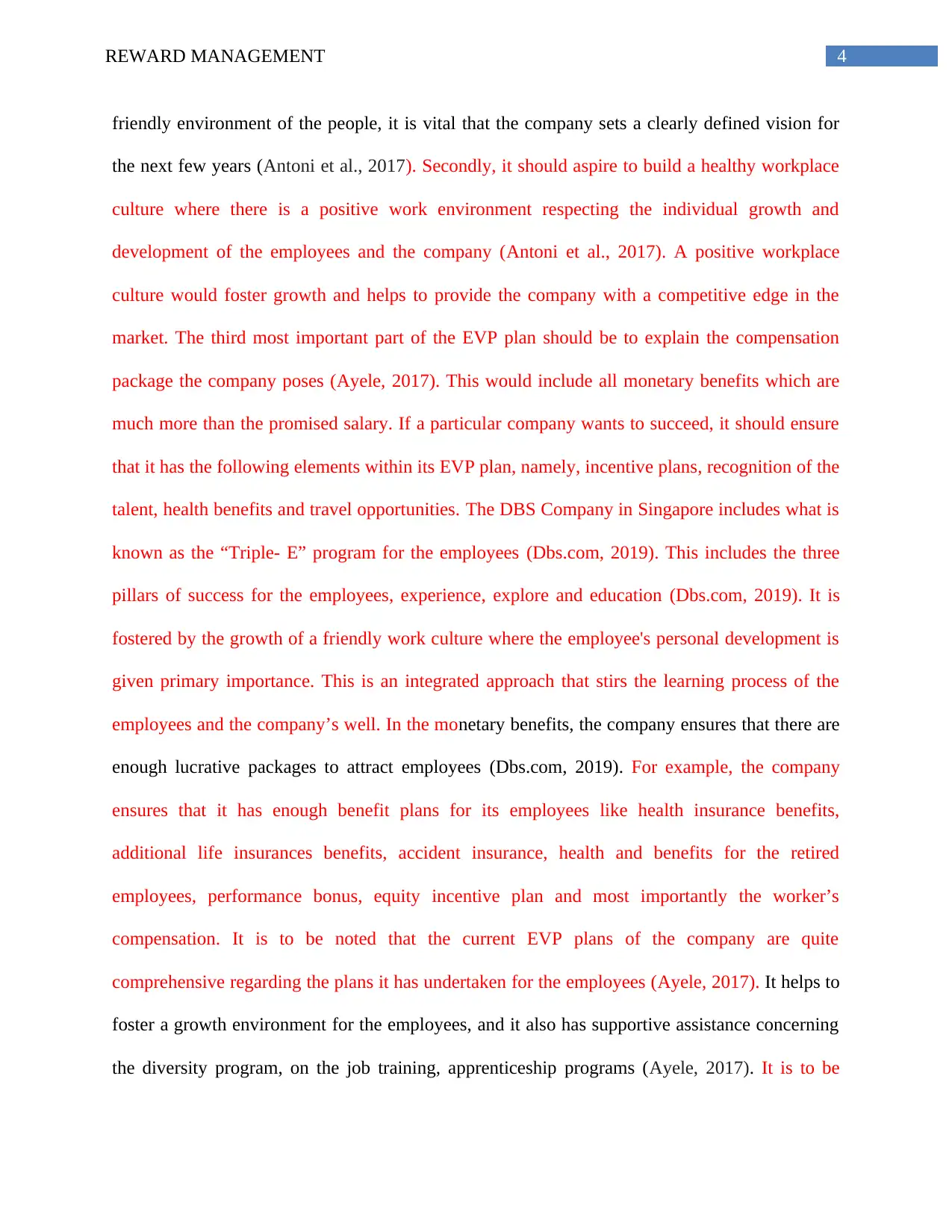
4REWARD MANAGEMENT
friendly environment of the people, it is vital that the company sets a clearly defined vision for
the next few years (Antoni et al., 2017). Secondly, it should aspire to build a healthy workplace
culture where there is a positive work environment respecting the individual growth and
development of the employees and the company (Antoni et al., 2017). A positive workplace
culture would foster growth and helps to provide the company with a competitive edge in the
market. The third most important part of the EVP plan should be to explain the compensation
package the company poses (Ayele, 2017). This would include all monetary benefits which are
much more than the promised salary. If a particular company wants to succeed, it should ensure
that it has the following elements within its EVP plan, namely, incentive plans, recognition of the
talent, health benefits and travel opportunities. The DBS Company in Singapore includes what is
known as the “Triple- E” program for the employees (Dbs.com, 2019). This includes the three
pillars of success for the employees, experience, explore and education (Dbs.com, 2019). It is
fostered by the growth of a friendly work culture where the employee's personal development is
given primary importance. This is an integrated approach that stirs the learning process of the
employees and the company’s well. In the monetary benefits, the company ensures that there are
enough lucrative packages to attract employees (Dbs.com, 2019). For example, the company
ensures that it has enough benefit plans for its employees like health insurance benefits,
additional life insurances benefits, accident insurance, health and benefits for the retired
employees, performance bonus, equity incentive plan and most importantly the worker’s
compensation. It is to be noted that the current EVP plans of the company are quite
comprehensive regarding the plans it has undertaken for the employees (Ayele, 2017). It helps to
foster a growth environment for the employees, and it also has supportive assistance concerning
the diversity program, on the job training, apprenticeship programs (Ayele, 2017). It is to be
friendly environment of the people, it is vital that the company sets a clearly defined vision for
the next few years (Antoni et al., 2017). Secondly, it should aspire to build a healthy workplace
culture where there is a positive work environment respecting the individual growth and
development of the employees and the company (Antoni et al., 2017). A positive workplace
culture would foster growth and helps to provide the company with a competitive edge in the
market. The third most important part of the EVP plan should be to explain the compensation
package the company poses (Ayele, 2017). This would include all monetary benefits which are
much more than the promised salary. If a particular company wants to succeed, it should ensure
that it has the following elements within its EVP plan, namely, incentive plans, recognition of the
talent, health benefits and travel opportunities. The DBS Company in Singapore includes what is
known as the “Triple- E” program for the employees (Dbs.com, 2019). This includes the three
pillars of success for the employees, experience, explore and education (Dbs.com, 2019). It is
fostered by the growth of a friendly work culture where the employee's personal development is
given primary importance. This is an integrated approach that stirs the learning process of the
employees and the company’s well. In the monetary benefits, the company ensures that there are
enough lucrative packages to attract employees (Dbs.com, 2019). For example, the company
ensures that it has enough benefit plans for its employees like health insurance benefits,
additional life insurances benefits, accident insurance, health and benefits for the retired
employees, performance bonus, equity incentive plan and most importantly the worker’s
compensation. It is to be noted that the current EVP plans of the company are quite
comprehensive regarding the plans it has undertaken for the employees (Ayele, 2017). It helps to
foster a growth environment for the employees, and it also has supportive assistance concerning
the diversity program, on the job training, apprenticeship programs (Ayele, 2017). It is to be
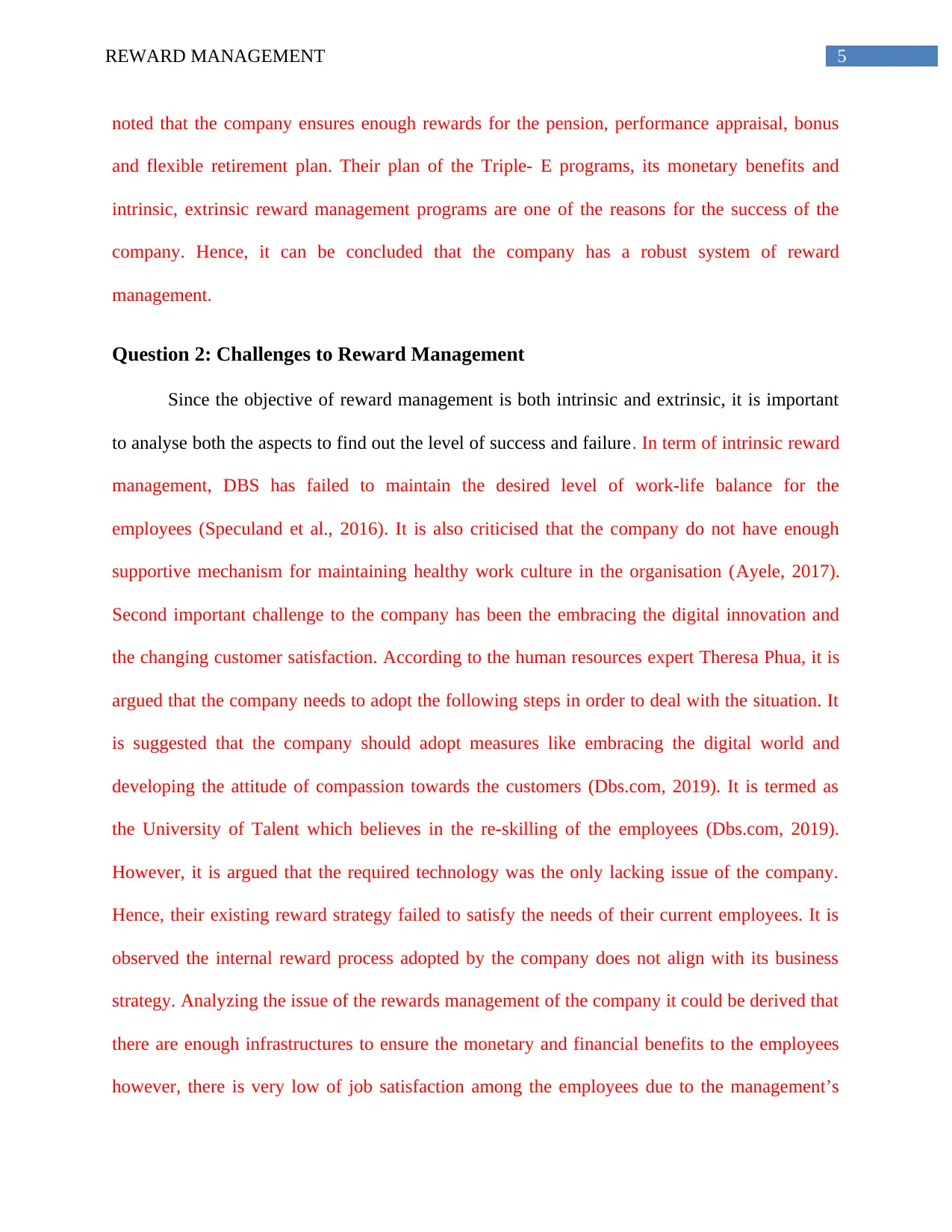
5REWARD MANAGEMENT
noted that the company ensures enough rewards for the pension, performance appraisal, bonus
and flexible retirement plan. Their plan of the Triple- E programs, its monetary benefits and
intrinsic, extrinsic reward management programs are one of the reasons for the success of the
company. Hence, it can be concluded that the company has a robust system of reward
management.
Question 2: Challenges to Reward Management
Since the objective of reward management is both intrinsic and extrinsic, it is important
to analyse both the aspects to find out the level of success and failure. In term of intrinsic reward
management, DBS has failed to maintain the desired level of work-life balance for the
employees (Speculand et al., 2016). It is also criticised that the company do not have enough
supportive mechanism for maintaining healthy work culture in the organisation (Ayele, 2017).
Second important challenge to the company has been the embracing the digital innovation and
the changing customer satisfaction. According to the human resources expert Theresa Phua, it is
argued that the company needs to adopt the following steps in order to deal with the situation. It
is suggested that the company should adopt measures like embracing the digital world and
developing the attitude of compassion towards the customers (Dbs.com, 2019). It is termed as
the University of Talent which believes in the re-skilling of the employees (Dbs.com, 2019).
However, it is argued that the required technology was the only lacking issue of the company.
Hence, their existing reward strategy failed to satisfy the needs of their current employees. It is
observed the internal reward process adopted by the company does not align with its business
strategy. Analyzing the issue of the rewards management of the company it could be derived that
there are enough infrastructures to ensure the monetary and financial benefits to the employees
however, there is very low of job satisfaction among the employees due to the management’s
noted that the company ensures enough rewards for the pension, performance appraisal, bonus
and flexible retirement plan. Their plan of the Triple- E programs, its monetary benefits and
intrinsic, extrinsic reward management programs are one of the reasons for the success of the
company. Hence, it can be concluded that the company has a robust system of reward
management.
Question 2: Challenges to Reward Management
Since the objective of reward management is both intrinsic and extrinsic, it is important
to analyse both the aspects to find out the level of success and failure. In term of intrinsic reward
management, DBS has failed to maintain the desired level of work-life balance for the
employees (Speculand et al., 2016). It is also criticised that the company do not have enough
supportive mechanism for maintaining healthy work culture in the organisation (Ayele, 2017).
Second important challenge to the company has been the embracing the digital innovation and
the changing customer satisfaction. According to the human resources expert Theresa Phua, it is
argued that the company needs to adopt the following steps in order to deal with the situation. It
is suggested that the company should adopt measures like embracing the digital world and
developing the attitude of compassion towards the customers (Dbs.com, 2019). It is termed as
the University of Talent which believes in the re-skilling of the employees (Dbs.com, 2019).
However, it is argued that the required technology was the only lacking issue of the company.
Hence, their existing reward strategy failed to satisfy the needs of their current employees. It is
observed the internal reward process adopted by the company does not align with its business
strategy. Analyzing the issue of the rewards management of the company it could be derived that
there are enough infrastructures to ensure the monetary and financial benefits to the employees
however, there is very low of job satisfaction among the employees due to the management’s
⊘ This is a preview!⊘
Do you want full access?
Subscribe today to unlock all pages.

Trusted by 1+ million students worldwide
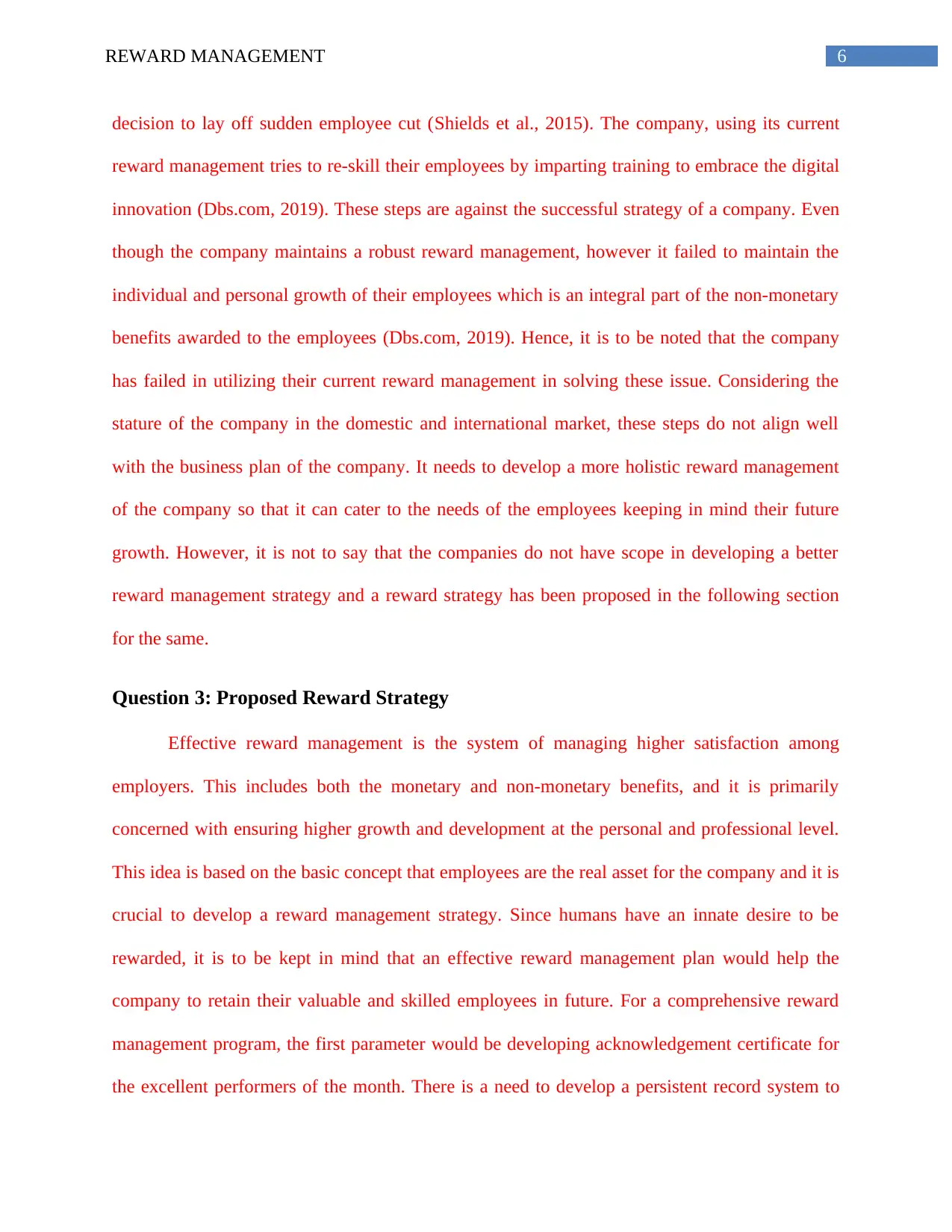
6REWARD MANAGEMENT
decision to lay off sudden employee cut (Shields et al., 2015). The company, using its current
reward management tries to re-skill their employees by imparting training to embrace the digital
innovation (Dbs.com, 2019). These steps are against the successful strategy of a company. Even
though the company maintains a robust reward management, however it failed to maintain the
individual and personal growth of their employees which is an integral part of the non-monetary
benefits awarded to the employees (Dbs.com, 2019). Hence, it is to be noted that the company
has failed in utilizing their current reward management in solving these issue. Considering the
stature of the company in the domestic and international market, these steps do not align well
with the business plan of the company. It needs to develop a more holistic reward management
of the company so that it can cater to the needs of the employees keeping in mind their future
growth. However, it is not to say that the companies do not have scope in developing a better
reward management strategy and a reward strategy has been proposed in the following section
for the same.
Question 3: Proposed Reward Strategy
Effective reward management is the system of managing higher satisfaction among
employers. This includes both the monetary and non-monetary benefits, and it is primarily
concerned with ensuring higher growth and development at the personal and professional level.
This idea is based on the basic concept that employees are the real asset for the company and it is
crucial to develop a reward management strategy. Since humans have an innate desire to be
rewarded, it is to be kept in mind that an effective reward management plan would help the
company to retain their valuable and skilled employees in future. For a comprehensive reward
management program, the first parameter would be developing acknowledgement certificate for
the excellent performers of the month. There is a need to develop a persistent record system to
decision to lay off sudden employee cut (Shields et al., 2015). The company, using its current
reward management tries to re-skill their employees by imparting training to embrace the digital
innovation (Dbs.com, 2019). These steps are against the successful strategy of a company. Even
though the company maintains a robust reward management, however it failed to maintain the
individual and personal growth of their employees which is an integral part of the non-monetary
benefits awarded to the employees (Dbs.com, 2019). Hence, it is to be noted that the company
has failed in utilizing their current reward management in solving these issue. Considering the
stature of the company in the domestic and international market, these steps do not align well
with the business plan of the company. It needs to develop a more holistic reward management
of the company so that it can cater to the needs of the employees keeping in mind their future
growth. However, it is not to say that the companies do not have scope in developing a better
reward management strategy and a reward strategy has been proposed in the following section
for the same.
Question 3: Proposed Reward Strategy
Effective reward management is the system of managing higher satisfaction among
employers. This includes both the monetary and non-monetary benefits, and it is primarily
concerned with ensuring higher growth and development at the personal and professional level.
This idea is based on the basic concept that employees are the real asset for the company and it is
crucial to develop a reward management strategy. Since humans have an innate desire to be
rewarded, it is to be kept in mind that an effective reward management plan would help the
company to retain their valuable and skilled employees in future. For a comprehensive reward
management program, the first parameter would be developing acknowledgement certificate for
the excellent performers of the month. There is a need to develop a persistent record system to
Paraphrase This Document
Need a fresh take? Get an instant paraphrase of this document with our AI Paraphraser
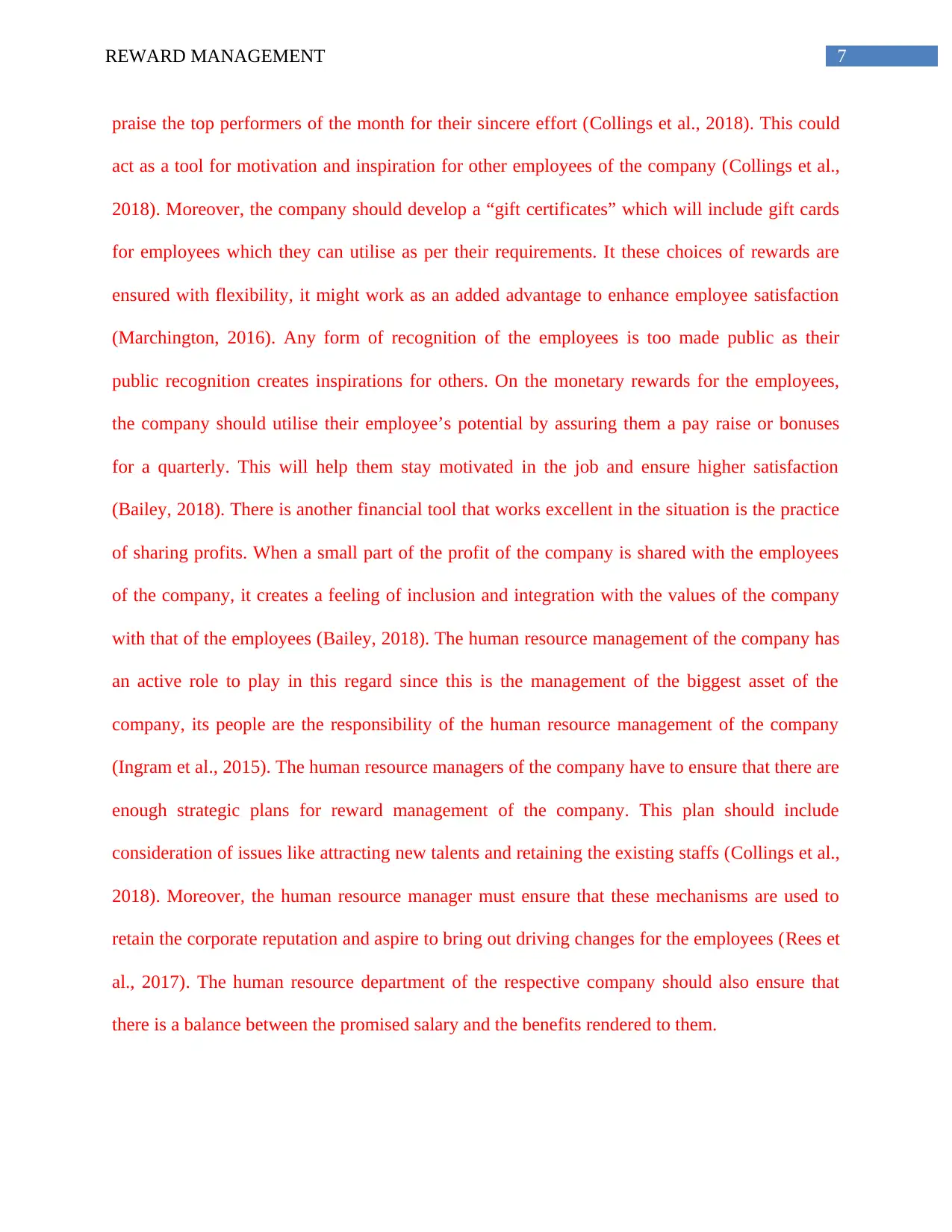
7REWARD MANAGEMENT
praise the top performers of the month for their sincere effort (Collings et al., 2018). This could
act as a tool for motivation and inspiration for other employees of the company (Collings et al.,
2018). Moreover, the company should develop a “gift certificates” which will include gift cards
for employees which they can utilise as per their requirements. It these choices of rewards are
ensured with flexibility, it might work as an added advantage to enhance employee satisfaction
(Marchington, 2016). Any form of recognition of the employees is too made public as their
public recognition creates inspirations for others. On the monetary rewards for the employees,
the company should utilise their employee’s potential by assuring them a pay raise or bonuses
for a quarterly. This will help them stay motivated in the job and ensure higher satisfaction
(Bailey, 2018). There is another financial tool that works excellent in the situation is the practice
of sharing profits. When a small part of the profit of the company is shared with the employees
of the company, it creates a feeling of inclusion and integration with the values of the company
with that of the employees (Bailey, 2018). The human resource management of the company has
an active role to play in this regard since this is the management of the biggest asset of the
company, its people are the responsibility of the human resource management of the company
(Ingram et al., 2015). The human resource managers of the company have to ensure that there are
enough strategic plans for reward management of the company. This plan should include
consideration of issues like attracting new talents and retaining the existing staffs (Collings et al.,
2018). Moreover, the human resource manager must ensure that these mechanisms are used to
retain the corporate reputation and aspire to bring out driving changes for the employees (Rees et
al., 2017). The human resource department of the respective company should also ensure that
there is a balance between the promised salary and the benefits rendered to them.
praise the top performers of the month for their sincere effort (Collings et al., 2018). This could
act as a tool for motivation and inspiration for other employees of the company (Collings et al.,
2018). Moreover, the company should develop a “gift certificates” which will include gift cards
for employees which they can utilise as per their requirements. It these choices of rewards are
ensured with flexibility, it might work as an added advantage to enhance employee satisfaction
(Marchington, 2016). Any form of recognition of the employees is too made public as their
public recognition creates inspirations for others. On the monetary rewards for the employees,
the company should utilise their employee’s potential by assuring them a pay raise or bonuses
for a quarterly. This will help them stay motivated in the job and ensure higher satisfaction
(Bailey, 2018). There is another financial tool that works excellent in the situation is the practice
of sharing profits. When a small part of the profit of the company is shared with the employees
of the company, it creates a feeling of inclusion and integration with the values of the company
with that of the employees (Bailey, 2018). The human resource management of the company has
an active role to play in this regard since this is the management of the biggest asset of the
company, its people are the responsibility of the human resource management of the company
(Ingram et al., 2015). The human resource managers of the company have to ensure that there are
enough strategic plans for reward management of the company. This plan should include
consideration of issues like attracting new talents and retaining the existing staffs (Collings et al.,
2018). Moreover, the human resource manager must ensure that these mechanisms are used to
retain the corporate reputation and aspire to bring out driving changes for the employees (Rees et
al., 2017). The human resource department of the respective company should also ensure that
there is a balance between the promised salary and the benefits rendered to them.
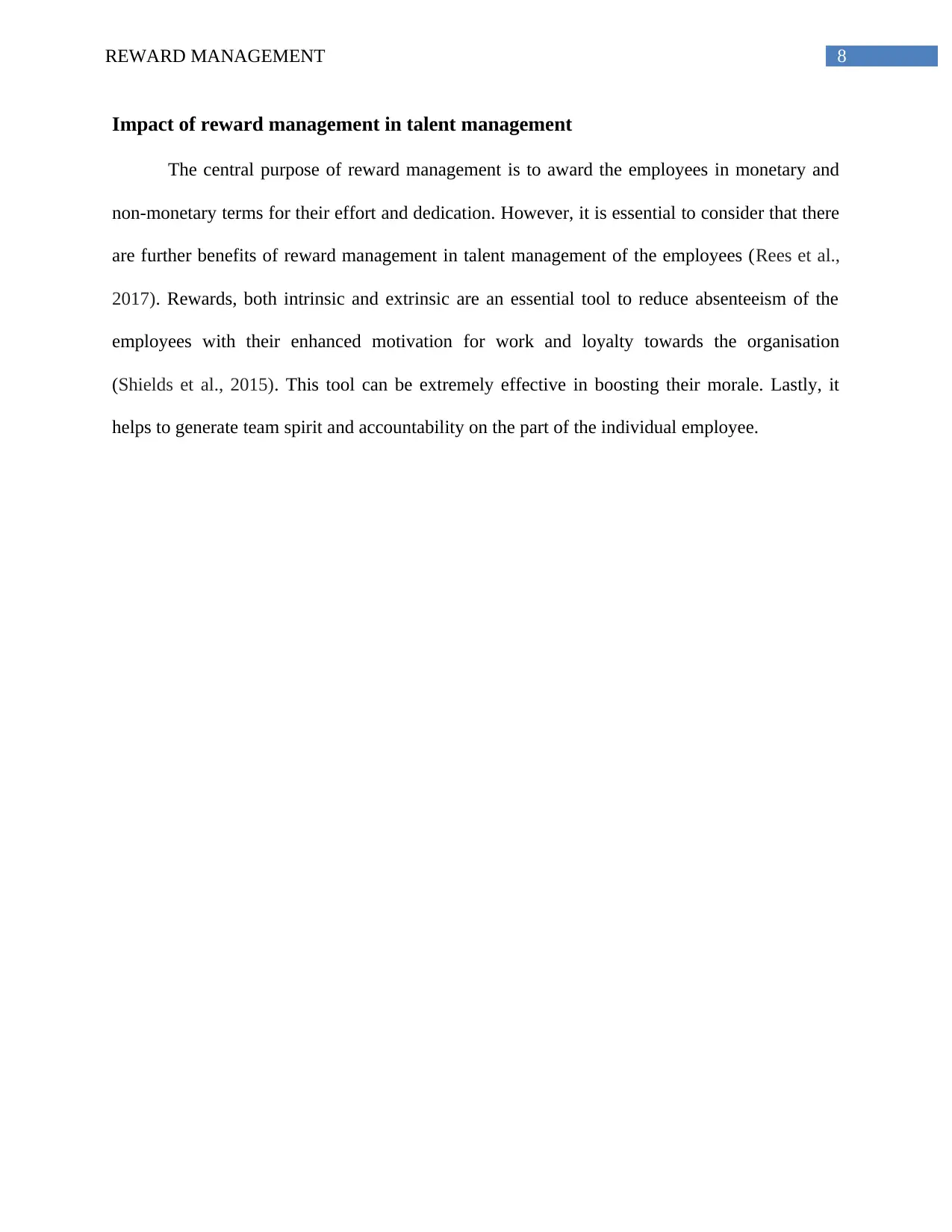
8REWARD MANAGEMENT
Impact of reward management in talent management
The central purpose of reward management is to award the employees in monetary and
non-monetary terms for their effort and dedication. However, it is essential to consider that there
are further benefits of reward management in talent management of the employees (Rees et al.,
2017). Rewards, both intrinsic and extrinsic are an essential tool to reduce absenteeism of the
employees with their enhanced motivation for work and loyalty towards the organisation
(Shields et al., 2015). This tool can be extremely effective in boosting their morale. Lastly, it
helps to generate team spirit and accountability on the part of the individual employee.
Impact of reward management in talent management
The central purpose of reward management is to award the employees in monetary and
non-monetary terms for their effort and dedication. However, it is essential to consider that there
are further benefits of reward management in talent management of the employees (Rees et al.,
2017). Rewards, both intrinsic and extrinsic are an essential tool to reduce absenteeism of the
employees with their enhanced motivation for work and loyalty towards the organisation
(Shields et al., 2015). This tool can be extremely effective in boosting their morale. Lastly, it
helps to generate team spirit and accountability on the part of the individual employee.
⊘ This is a preview!⊘
Do you want full access?
Subscribe today to unlock all pages.

Trusted by 1+ million students worldwide
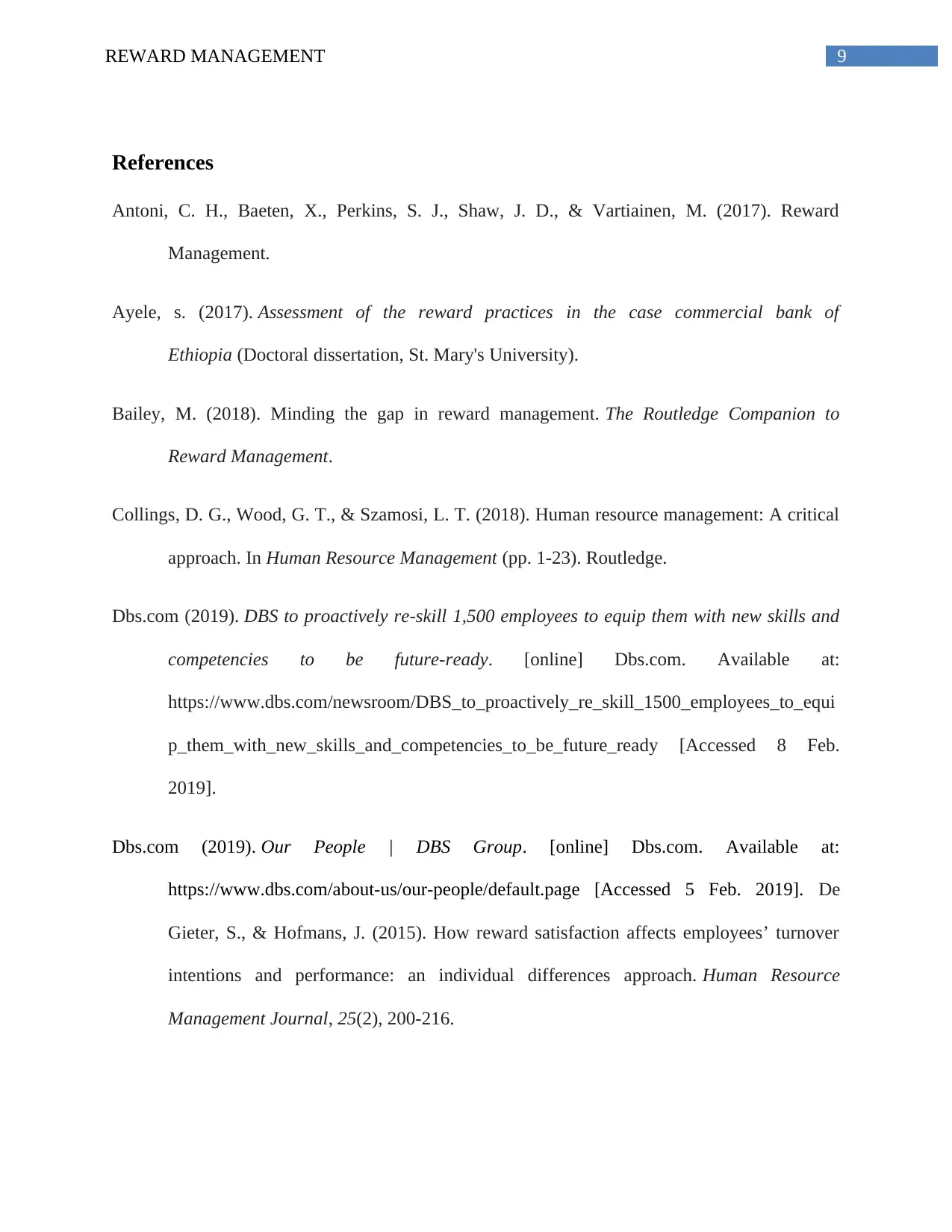
9REWARD MANAGEMENT
References
Antoni, C. H., Baeten, X., Perkins, S. J., Shaw, J. D., & Vartiainen, M. (2017). Reward
Management.
Ayele, s. (2017). Assessment of the reward practices in the case commercial bank of
Ethiopia (Doctoral dissertation, St. Mary's University).
Bailey, M. (2018). Minding the gap in reward management. The Routledge Companion to
Reward Management.
Collings, D. G., Wood, G. T., & Szamosi, L. T. (2018). Human resource management: A critical
approach. In Human Resource Management (pp. 1-23). Routledge.
Dbs.com (2019). DBS to proactively re-skill 1,500 employees to equip them with new skills and
competencies to be future-ready. [online] Dbs.com. Available at:
https://www.dbs.com/newsroom/DBS_to_proactively_re_skill_1500_employees_to_equi
p_them_with_new_skills_and_competencies_to_be_future_ready [Accessed 8 Feb.
2019].
Dbs.com (2019). Our People | DBS Group. [online] Dbs.com. Available at:
https://www.dbs.com/about-us/our-people/default.page [Accessed 5 Feb. 2019]. De
Gieter, S., & Hofmans, J. (2015). How reward satisfaction affects employees’ turnover
intentions and performance: an individual differences approach. Human Resource
Management Journal, 25(2), 200-216.
References
Antoni, C. H., Baeten, X., Perkins, S. J., Shaw, J. D., & Vartiainen, M. (2017). Reward
Management.
Ayele, s. (2017). Assessment of the reward practices in the case commercial bank of
Ethiopia (Doctoral dissertation, St. Mary's University).
Bailey, M. (2018). Minding the gap in reward management. The Routledge Companion to
Reward Management.
Collings, D. G., Wood, G. T., & Szamosi, L. T. (2018). Human resource management: A critical
approach. In Human Resource Management (pp. 1-23). Routledge.
Dbs.com (2019). DBS to proactively re-skill 1,500 employees to equip them with new skills and
competencies to be future-ready. [online] Dbs.com. Available at:
https://www.dbs.com/newsroom/DBS_to_proactively_re_skill_1500_employees_to_equi
p_them_with_new_skills_and_competencies_to_be_future_ready [Accessed 8 Feb.
2019].
Dbs.com (2019). Our People | DBS Group. [online] Dbs.com. Available at:
https://www.dbs.com/about-us/our-people/default.page [Accessed 5 Feb. 2019]. De
Gieter, S., & Hofmans, J. (2015). How reward satisfaction affects employees’ turnover
intentions and performance: an individual differences approach. Human Resource
Management Journal, 25(2), 200-216.
Paraphrase This Document
Need a fresh take? Get an instant paraphrase of this document with our AI Paraphraser
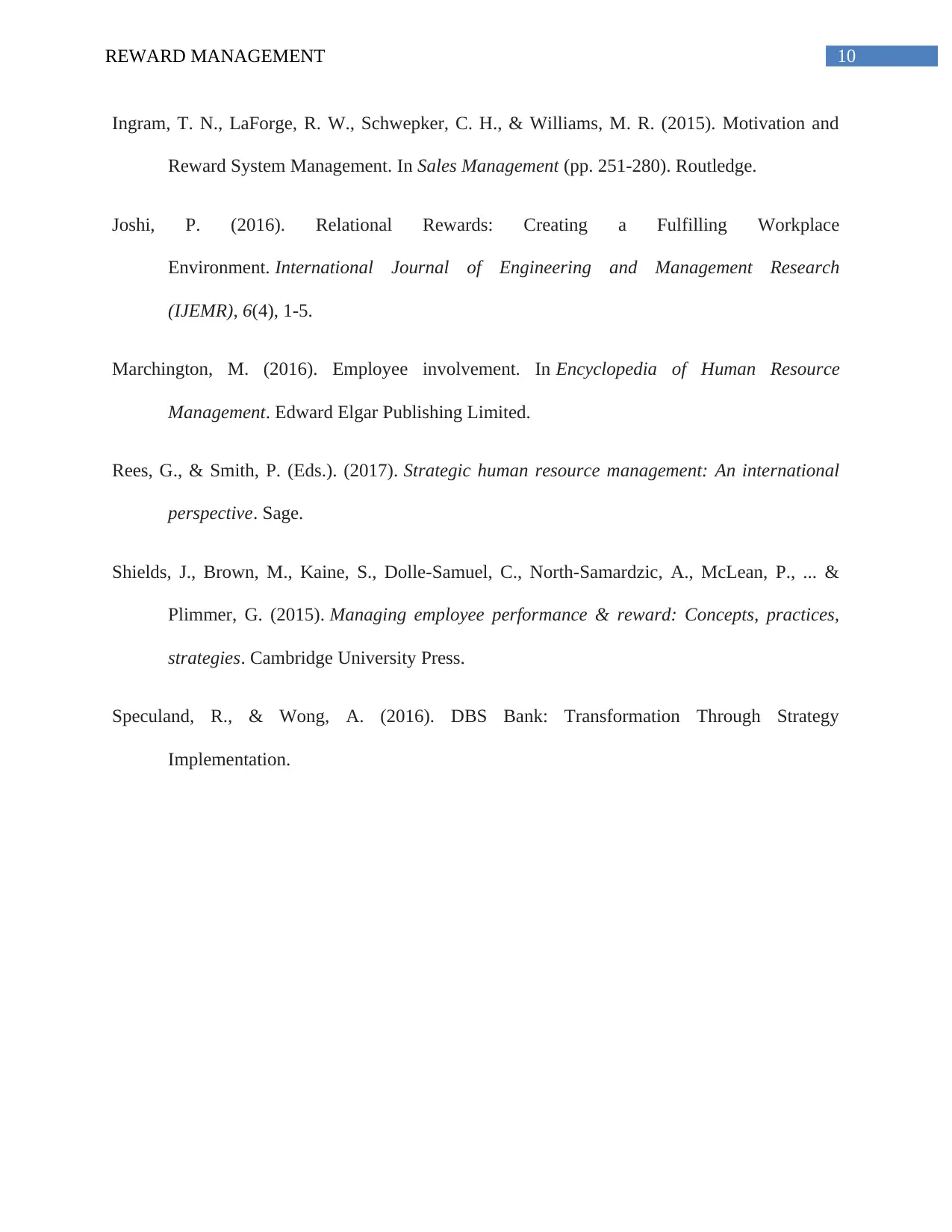
10REWARD MANAGEMENT
Ingram, T. N., LaForge, R. W., Schwepker, C. H., & Williams, M. R. (2015). Motivation and
Reward System Management. In Sales Management (pp. 251-280). Routledge.
Joshi, P. (2016). Relational Rewards: Creating a Fulfilling Workplace
Environment. International Journal of Engineering and Management Research
(IJEMR), 6(4), 1-5.
Marchington, M. (2016). Employee involvement. In Encyclopedia of Human Resource
Management. Edward Elgar Publishing Limited.
Rees, G., & Smith, P. (Eds.). (2017). Strategic human resource management: An international
perspective. Sage.
Shields, J., Brown, M., Kaine, S., Dolle-Samuel, C., North-Samardzic, A., McLean, P., ... &
Plimmer, G. (2015). Managing employee performance & reward: Concepts, practices,
strategies. Cambridge University Press.
Speculand, R., & Wong, A. (2016). DBS Bank: Transformation Through Strategy
Implementation.
Ingram, T. N., LaForge, R. W., Schwepker, C. H., & Williams, M. R. (2015). Motivation and
Reward System Management. In Sales Management (pp. 251-280). Routledge.
Joshi, P. (2016). Relational Rewards: Creating a Fulfilling Workplace
Environment. International Journal of Engineering and Management Research
(IJEMR), 6(4), 1-5.
Marchington, M. (2016). Employee involvement. In Encyclopedia of Human Resource
Management. Edward Elgar Publishing Limited.
Rees, G., & Smith, P. (Eds.). (2017). Strategic human resource management: An international
perspective. Sage.
Shields, J., Brown, M., Kaine, S., Dolle-Samuel, C., North-Samardzic, A., McLean, P., ... &
Plimmer, G. (2015). Managing employee performance & reward: Concepts, practices,
strategies. Cambridge University Press.
Speculand, R., & Wong, A. (2016). DBS Bank: Transformation Through Strategy
Implementation.
1 out of 11
Related Documents
Your All-in-One AI-Powered Toolkit for Academic Success.
+13062052269
info@desklib.com
Available 24*7 on WhatsApp / Email
![[object Object]](/_next/static/media/star-bottom.7253800d.svg)
Unlock your academic potential
Copyright © 2020–2025 A2Z Services. All Rights Reserved. Developed and managed by ZUCOL.





